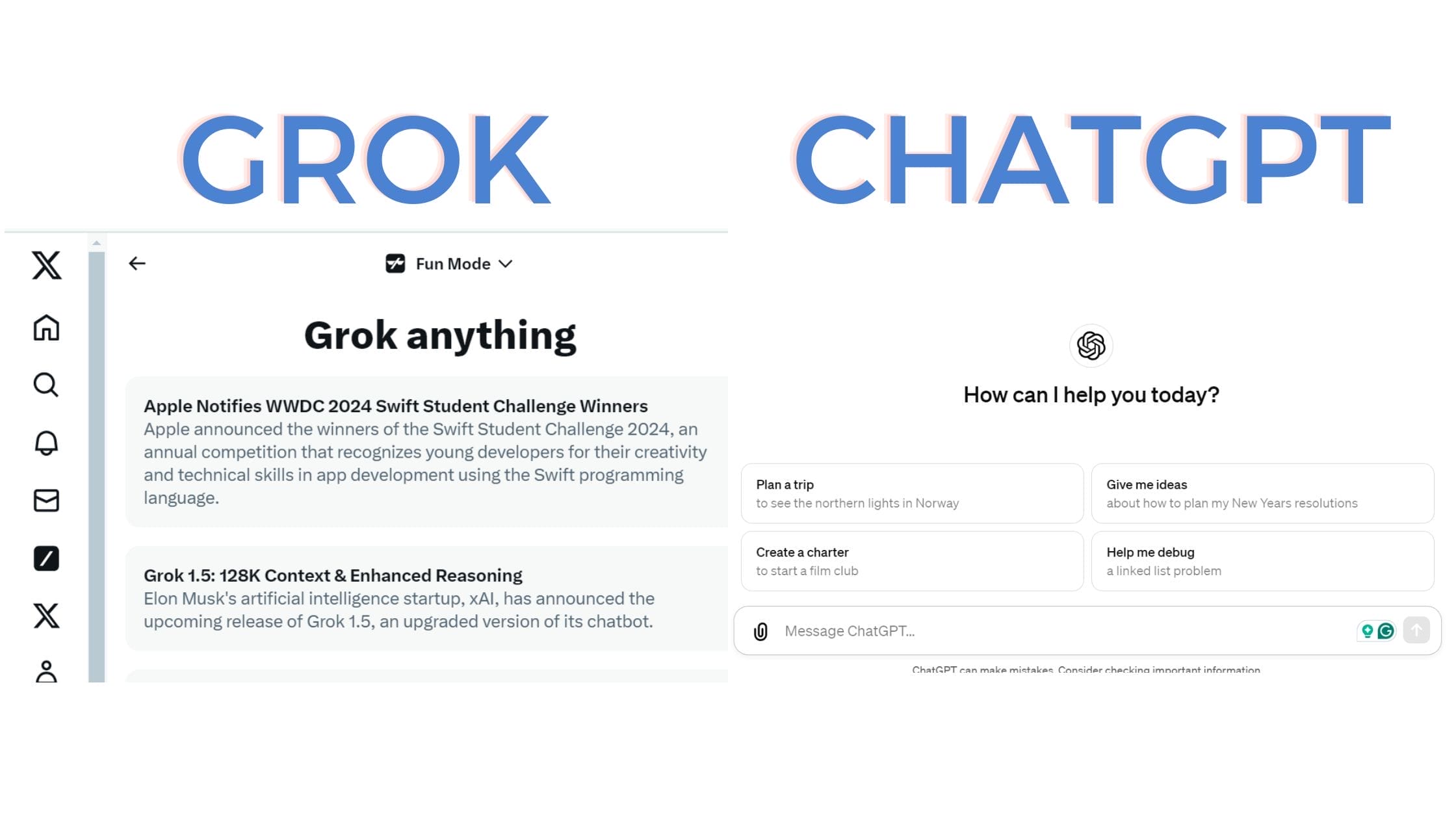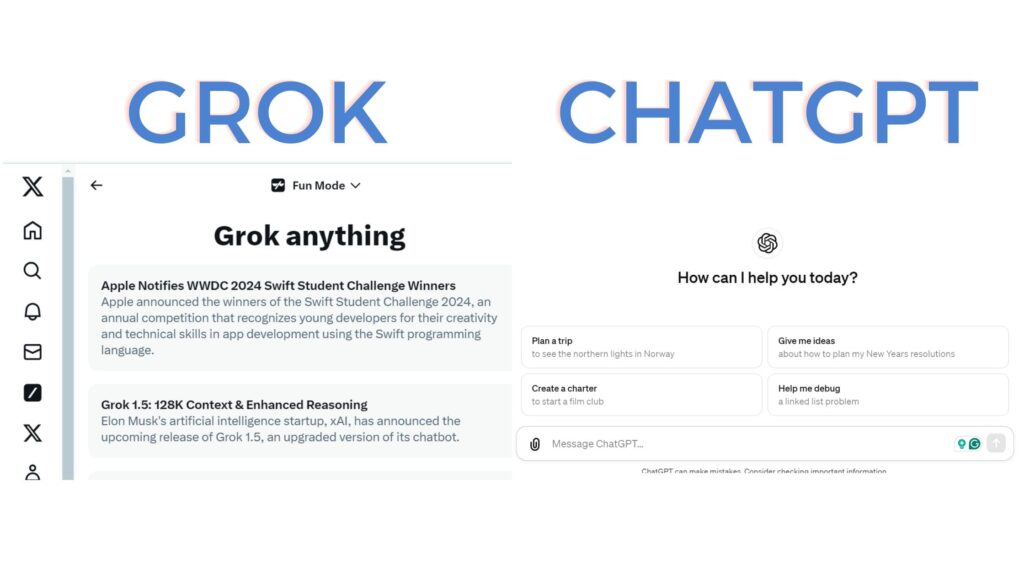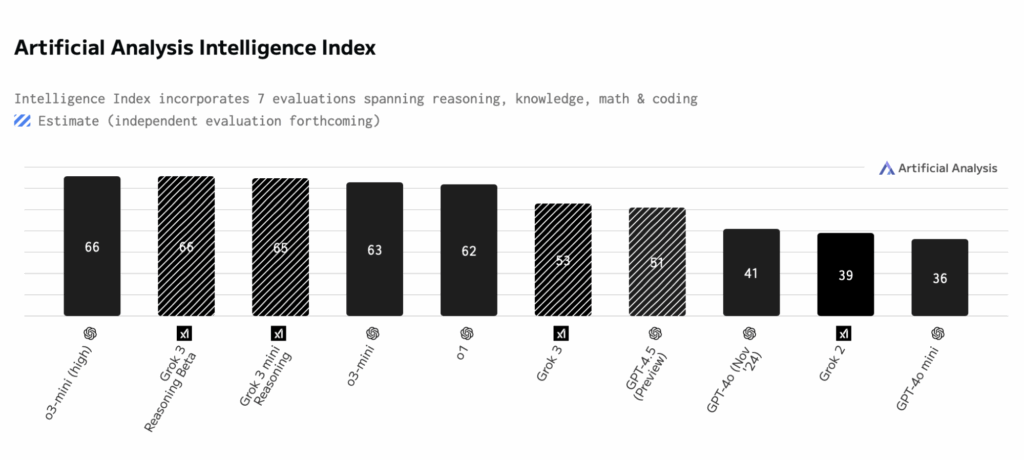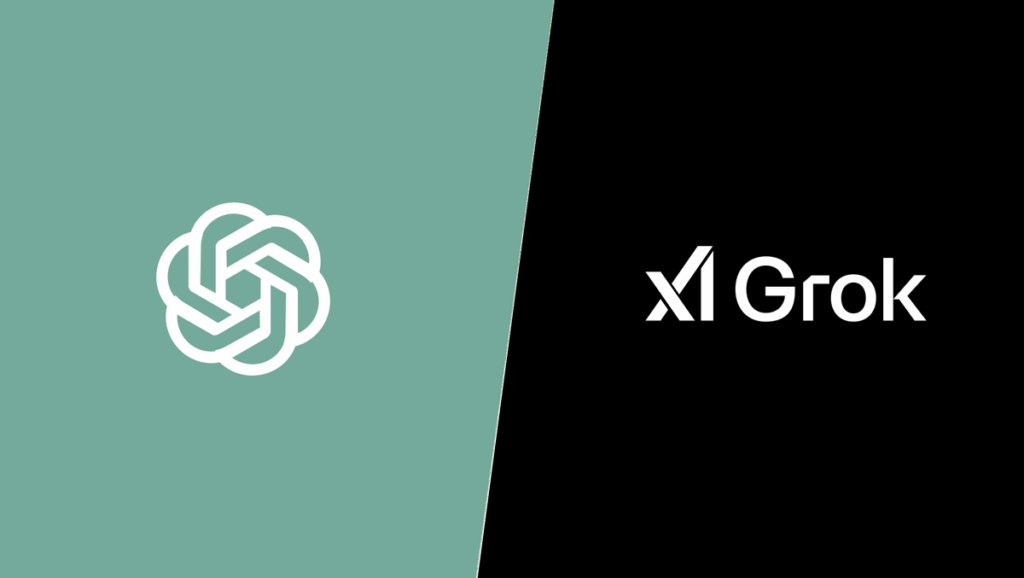The world of Artificial Intelligence is evolving at a breakneck pace, introducing incredible tools that are reshaping how we work, learn, and create. Among the most talked-about advancements are Large Language Models (LLMs) – powerful AI programs that can understand and generate human-like text. Two significant players that have recently captured headlines are ChatGPT and Grok. But what exactly are they, and what sets them apart? As your guide from AskByteWise.com, my mission is to break down this complex tech into simple, understandable terms. In this comprehensive article, we’ll dive deep into ChatGPT vs Grok, exploring their unique features, strengths, and ideal use cases to help you decide which AI companion might be right for your needs.
The AI Revolution and Why ChatGPT vs Grok Matters
Imagine a future where you have an intelligent assistant for every task – from drafting emails to brainstorming complex ideas. That future is increasingly here, thanks to AI. Large Language Models are at the forefront of this revolution. Think of an LLM as a highly sophisticated digital brain, trained on an enormous amount of text and code, allowing it to understand context, generate coherent responses, and even learn from interactions. These models are not just glorified search engines; they’re creative partners, problem-solvers, and information synthesizers.
ChatGPT, developed by OpenAI, burst onto the scene and quickly became a household name, demonstrating the immense potential of conversational AI. It showed us that AI could be accessible, versatile, and genuinely helpful for everyday tasks. Then came Grok, a newer contender from xAI, Elon Musk’s AI venture, promising a different kind of interaction – one with real-time data access and a distinct personality. The emergence of Grok alongside the established ChatGPT creates an interesting dynamic, offering users more choices and specialized functionalities. Understanding the nuances between ChatGPT vs Grok isn’t just an academic exercise; it’s crucial for anyone looking to leverage AI effectively, whether you’re a student, a small business owner, or simply curious about the future of technology.
Decoding ChatGPT: Your Versatile AI Companion
ChatGPT isn’t just an AI; it’s a phenomenon that introduced millions to the practical power of large language models. Developed by OpenAI, it’s akin to having a super-intelligent assistant at your fingertips, ready to help with a vast array of tasks.
What is ChatGPT and How Does It Work?
At its core, ChatGPT is a generative AI model that specializes in understanding and generating human-like text. It’s built upon a sophisticated neural network architecture (specifically, the Transformer architecture), which allows it to process sequences of words, predict the next most probable word, and construct coherent sentences and paragraphs.
Analogy: Imagine ChatGPT as an incredibly well-read librarian who has devoured almost every book, article, and piece of text ever written on the internet up until a certain point (its “knowledge cut-off”). When you ask it a question, it doesn’t just pull facts from a database; it uses its vast training to understand your query’s context and generate a unique, relevant, and grammatically correct answer, almost as if it’s composing a new passage on the spot.
Key Features and Strengths of ChatGPT
- Vast Knowledge Base: ChatGPT has been trained on an immense dataset, giving it a broad understanding of countless topics, historical events, scientific concepts, and cultural information.
- Exceptional Versatility: This is where ChatGPT truly shines. It can write articles, compose emails, draft code, brainstorm ideas, summarize documents, translate languages, answer complex questions, and even generate creative content like poems or stories.
- User-Friendly Interface: OpenAI has made ChatGPT incredibly accessible. You type in your query (a “prompt”), and it responds. Its conversational nature makes it easy for anyone to use, regardless of technical expertise.
- Contextual Understanding: It maintains context within a conversation, allowing for follow-up questions and refined requests, making interactions feel more natural and productive.
- Continuous Improvement: OpenAI regularly releases updated versions (like GPT-3.5 and GPT-4), each bringing enhanced capabilities, better reasoning, and reduced “hallucinations” (where the AI confidently states incorrect information).
Limitations to Keep in Mind
While powerful, ChatGPT isn’t without its caveats:
- Knowledge Cut-off: Its standard training data has a specific cut-off date. This means it might not have information on very recent events or developments, although newer versions like GPT-4 can access real-time information via web browsing.
- Lack of Real-time Data by Default: Unlike Grok, the standard free version of ChatGPT doesn’t inherently access real-time news or social media feeds.
- Potential for Generic Responses: Due to its broad training, responses can sometimes feel generic or lack a distinct “personality” unless specifically prompted.
- Accuracy Concerns: While generally accurate, it can still “hallucinate” or provide incorrect information, especially on obscure topics or when pressed for definitive answers it hasn’t been explicitly trained on. Always cross-reference critical information.
Practical Use Cases for ChatGPT
- Content Creation: Blog posts, marketing copy, social media updates, video scripts.
- Education & Learning: Explaining complex concepts, generating study guides, practicing language skills.
- Programming & Debugging: Writing code snippets, debugging errors, understanding programming concepts.
- Business Operations: Drafting emails, summarizing reports, generating meeting agendas, customer service support.
- Creative Writing: Brainstorming story ideas, writing fiction, poetry, or song lyrics.
Understanding Grok: The Witty Newcomer
Stepping into the AI arena with a distinct personality and a bold claim is Grok, a product of xAI, founded by none other than Elon Musk. Grok isn’t just another language model; it’s designed to be a “rebellious” AI with a unique approach to information and interaction.
What is Grok and How Does It Work?
Grok is xAI’s large language model, developed with the explicit goal of being able to answer almost anything and, importantly, do so with a touch of wit and sarcasm. What truly sets Grok apart is its real-time access to information from the X platform (formerly Twitter).
Analogy: If ChatGPT is the erudite librarian, Grok is the sharp, opinionated, and well-informed journalist who’s always got their finger on the pulse of current events, scrolling through the latest news and discussions on X. This journalist also happens to have a wicked sense of humor and isn’t afraid to share it.
Key Features and Strengths of Grok
- Real-time Information: This is Grok’s standout feature. By leveraging data from X, Grok can discuss current events, breaking news, and trending topics with a level of up-to-the-minute awareness that traditional LLMs often lack. This makes it incredibly valuable for understanding real-time sentiment or emerging discussions.
- Distinct Personality: Grok is designed to be humorous and sarcastic, offering responses that are often more engaging and less robotic than other AIs. This “personality” can make interactions feel more human and entertaining, especially for users who appreciate a bit of edge.
- “Rebellious” and Unfiltered: xAI explicitly states Grok is intended to answer questions that other AIs might reject due to safety or policy guidelines. While this promises more candid responses, it also comes with a need for user discretion.
- Developed by xAI (Elon Musk): The backing of Elon Musk and his vision for “maximally curious” AI gives Grok a strong, if sometimes controversial, identity in the AI landscape.
- Focus on Understanding the Universe: While a lofty goal, xAI’s broader mission for Grok is to understand the true nature of the universe, implying a long-term development path focused on deep, fundamental knowledge.
Limitations to Consider
As a newer model, Grok also has its own set of limitations:
- Newer and Less Refined: Being newer to the public, Grok may still be in an earlier stage of development compared to the more mature ChatGPT, potentially leading to less consistent performance in certain areas.
- X-centric Data Bias: While real-time data from X is a strength, it’s also a potential limitation. The platform’s content can be highly opinionated, biased, or even misleading, which Grok’s responses might reflect.
- Limited Accessibility: Grok is currently only available to Premium+ subscribers of X, limiting its access compared to ChatGPT, which has a widely accessible free tier.
- Humor/Sarcasm Can Be Misinterpreted: While its personality is a feature, humor, especially sarcasm, can be subjective and sometimes misunderstood, particularly by a global audience or in serious contexts.
- Ethical Concerns: Its “rebellious” nature and willingness to answer controversial questions raise important ethical considerations regarding misinformation, hate speech, and bias.
ChatGPT vs Grok: A Head-to-Head Battle of the Bots
Now that we’ve looked at each AI individually, let’s put them side-by-side to highlight their key differences. Understanding these distinctions is crucial when deciding which tool aligns best with your specific needs. This isn’t about one being “better” than the other universally, but rather about which is better for you and your unique tasks.
| Feature / Aspect | ChatGPT (OpenAI) | Grok (xAI) |
|---|---|---|
| Developer | OpenAI | xAI (Elon Musk’s company) |
| Core Philosophy | Broad utility, safety, general-purpose intelligence, accessibility. | Maximally curious, rebellious, humorous, real-time insights from X. |
| Primary Data Source | Vast, diverse dataset of text and code (pre-trained up to a cut-off date). | Real-time access to X (formerly Twitter) data, alongside other training data. |
| Knowledge Base | Extensive historical and general knowledge. | Strong in current events, trending topics, and real-time social sentiment. |
| Tone & Personality | Generally neutral, helpful, informative, professional. | Witty, sarcastic, humorous, more casual, and opinionated. |
| Real-time Information | Not inherently in free versions; available via plugins/web browsing in paid versions. | Core feature, directly integrated with X for up-to-the-minute data. |
| Best Use Cases | Content creation, coding, education, research, summarization, brainstorming, general Q&A. | Real-time news analysis, tracking trends, generating quick, edgy commentary, understanding public sentiment. |
| Availability | Free tier widely available; paid tiers (ChatGPT Plus) offer advanced features. | Currently limited to X Premium+ subscribers. |
| User Experience | Polished, reliable, comprehensive. | Engaging, potentially more entertaining, but newer. |
| Ethical Considerations | Focus on safety guidelines, reducing bias, but still prone to “hallucination.” | Willingness to answer controversial questions; potential for reflecting biases present on X. |
Choosing Your AI Ally: Who Wins for You?
The question isn’t whether ChatGPT is “better” than Grok or vice-versa, but rather which AI tool is better suited for your specific requirements. Both are incredibly powerful, yet they cater to different needs and user preferences.
When to Lean Towards ChatGPT
- For Comprehensive & General Tasks: If your work involves writing long-form content, summarizing complex documents, brainstorming diverse ideas, learning a new skill, or getting help with coding, ChatGPT’s broad knowledge and versatile capabilities make it an excellent choice.
- For Professional & Neutral Tone: When you need output that is consistently professional, factual (with proper verification), and free from overt personality, ChatGPT’s default neutral tone is ideal.
- For Broad Accessibility: The free tier of ChatGPT makes it accessible to almost everyone, from students to small business owners, without needing a subscription to X.
- For Established Reliability: Having been in the public eye longer, ChatGPT’s various iterations have undergone extensive refinement, making it a more predictable and generally reliable tool for a wide range of tasks.
Noah’s Tip: “Think of ChatGPT as your Swiss Army knife of AI – incredibly versatile and generally reliable for almost any task you throw at it. It’s your go-to for productivity and information synthesis across a wide spectrum of topics.”
When to Opt for Grok
- For Real-time Insights & Current Events: If staying abreast of the absolute latest news, trending topics on social media, or understanding public sentiment as it happens is critical, Grok’s real-time access to X data gives it a significant advantage.
- For Engaging & Witty Interactions: If you appreciate an AI with a distinct, humorous, and even sarcastic personality, and your tasks can benefit from a more lively and less formal tone, Grok will likely be more entertaining and engaging.
- For Unfiltered Perspectives (with caution): For users seeking less filtered answers or discussions on controversial topics (again, with the understanding that this requires critical thinking and verification), Grok’s “rebellious” nature might appeal.
- If You’re Already an X Premium+ Subscriber: For those already invested in the X ecosystem, Grok becomes an integrated and potentially valuable addition to their digital toolkit.
Noah’s Tip: “Consider Grok if you need a quick-witted, up-to-the-minute AI companion, like a sharp news anchor who also tells jokes. Just remember to verify its ‘hot takes’ with other sources, especially on sensitive subjects!”
Ultimately, the best choice might even be both. Many advanced users of AI employ multiple models, leveraging each for its specific strengths. You might use ChatGPT for in-depth content creation and summarization, while turning to Grok for a pulse check on social media trends or a quick, witty take on a current event.
The Road Ahead: What’s Next for AI?
The rapid evolution of AI, particularly in the realm of large language models, suggests an exciting and transformative future. The emergence of models like ChatGPT and Grok highlights several key trends we can expect to see intensify:
- Specialization and Personalization: We’re moving beyond general-purpose AIs towards models that are highly specialized for specific industries or tasks. Imagine AIs specifically trained for legal research, medical diagnostics, or creative art generation, each with unparalleled depth in its domain. Furthermore, AI will become increasingly personalized, learning individual user preferences and styles to offer tailored assistance.
- Multimodality: Current LLMs are primarily text-based, but the future is multimodal. This means AI models that can seamlessly understand and generate content across various formats – text, images, audio, video – interacting with the world in a more holistic way. We’re already seeing glimpses of this with image-generation AIs and voice assistants.
- Ethical AI and Safety: As AI becomes more powerful and integrated into daily life, the focus on ethical development, bias mitigation, transparency, and safety will become paramount. Debates around AI ethics, privacy, and potential misuse will continue to shape policy and development, ensuring these tools benefit humanity responsibly.
- Accessibility and Integration: AI will become even more ubiquitous, integrated into everything from our smart home devices to our productivity software. The goal is to make AI assistance as seamless and invisible as possible, empowering users without requiring deep technical knowledge.
- Human-AI Collaboration: Rather than replacing humans, AI is increasingly seen as a co-pilot, enhancing human capabilities. The focus will be on designing AI systems that augment human creativity, problem-solving, and decision-making, allowing us to achieve more together.
The competition between robust, established players like OpenAI’s ChatGPT and ambitious, personality-driven challengers like xAI’s Grok is a healthy sign of innovation. It pushes the boundaries of what AI can do, leading to more diverse and powerful tools for everyone. As users, our role is to understand these tools, leverage their strengths wisely, and critically evaluate their outputs to ensure we get the most out of this incredible technological revolution.
Frequently Asked Questions (FAQ)
Q1: Is Grok available for everyone?
A1: Currently, Grok is primarily available to subscribers of X Premium+, which is the highest tier of the paid subscription service for X (formerly Twitter). This limits its general accessibility compared to the widely available free version of ChatGPT.
Q2: Can Grok access the internet for real-time information like ChatGPT Plus?
A2: Grok’s primary strength for real-time information comes from its direct access to the X platform’s data. While ChatGPT Plus offers web browsing capabilities to get real-time information from the broader internet, Grok’s real-time advantage is specifically tied to the dynamic content flowing through X.
Q3: Which AI is better for creative writing?
A3: For most forms of creative writing, such as crafting stories, poems, or complex narratives, ChatGPT, especially models like GPT-4, generally offers more nuanced and diverse creative capabilities due to its extensive and varied training data. Grok can be creative, particularly with humorous or sarcastic takes, but its focus isn’t primarily on broad creative writing.
Q4: Are Grok’s humorous responses always appropriate?
A4: Grok is designed with a witty and sometimes sarcastic personality, which can be entertaining. However, humor is subjective, and what’s appropriate can vary by context and culture. Users should exercise discretion, especially when using Grok for professional or sensitive topics, as its responses might not always align with desired formality or tone.
Q5: How do “hallucinations” differ between ChatGPT and Grok?
A5: Both ChatGPT and Grok, like all generative AI models, can “hallucinate” or provide incorrect information with confidence. For ChatGPT, hallucinations often stem from making up facts or details not present in its training data, especially when it tries to fill knowledge gaps. For Grok, while it has real-time data from X, it could still misinterpret trends, reflect biases present on X, or even generate humorous but factually inaccurate responses, requiring critical user evaluation.
See more: chatgpt vs grok.
Discover: AskByteWise.



